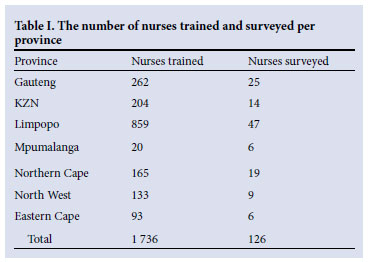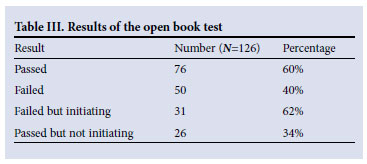Services on Demand
Article
Indicators
Related links
-
 Cited by Google
Cited by Google -
 Similars in Google
Similars in Google
Share
SAMJ: South African Medical Journal
On-line version ISSN 2078-5135
Print version ISSN 0256-9574
SAMJ, S. Afr. med. j. vol.102 n.2 Pretoria Feb. 2012
ORIGINAL ARTICLES
Nurse initiation and maintenance of patients on antiretroviral therapy: are nurses in primary care clinics initiating ART after attending NIMART training?
David CameronI; Amor GerberII; Melusi MbathaV; Judith MutyabuleIII; Helga SwartIV
IMB ChB, M Prax Med, M Phil, FCFP (SA). Department of Family Medicine, University of Pretoria; and Foundation for Professional Development, Pretoria
IIB Comm, DTE, SLP. Foundation for Professional Development, Pretoria
IIIBFST, B Cur. Foundation for Professional Development, Pretoria
IVHCM. Foundation for Professional Development, Pretoria
VBA (Hons) Psychol. University of South Africa, Pretoria
ABSTRACT
OBJECTIVES: To determine the percentage of nurses initiating new HIVpositive patients on therapy within 2 months of attending the Nurse Initiation and Maintenance of Antiretroviral Therapy (NIMART) course, and to identify possible barriers to nurse initiation.
METHODS: A brief telephonic interview using a structured questionnaire of a randomly selected sample (126/1 736) of primary care nurses who had attended the NIMART course facilitated by the Foundation for Professional Development (FPD) between October 2010 and 31 March 2011 at primary care clinics in 7 provinces. Outcome measures were the number of nurses initiating ART within 2 months of attending the FPD-facilitated NIMART course.
RESULTS: Of the nurses surveyed, 62% (79/126) had started initiating new adult patients on ART, but only 7% (9/126) were initiating ART in children. The main barrier to initiation was allocation to other tasks in the clinic as a result of staff shortages.
CONCLUSIONS: Despite numerous challenges, many primary care nurses working in the 7 provinces surveyed have taken on the responsibility of sharing the task of initiating HIV-positive patients on ART. The barriers preventing more nurses initiating ART include the shortage of primary care nurses and the lack of sufficient consulting rooms. Expanding clinical mentoring and further training in clinical skills and pharmacology would assist in reaching the target of initiating a further 1.2 million HIV-positve patients on ART by 2012.
Despite the remarkable achievement of the scale-up of antiretroviral therapy (ART) in South Africa over the past 7 years (about 1 million people on ART), the estimated number of people (1.2 million) requiring treatment in the next 2 years exceeds the capacity of the healthcare system if treatment continues to be initiated only by doctors.1-3
In South Africa, there are 69 doctors and 388 nurses per 100 000 population.3 Task-shifting from doctors to nurses for initiating and maintaining ART is a logical strategy to meet the need of increased access.2,4,5 Nurse initiation and maintenance of antiretroviral therapy (NIMART) improves access, is cost effective, is not inferior to doctor managed ART, and achieves similar outcomes of viral suppression, adherence, toxicity and death.4,6 Further motivation to rapidly improve access is evidence showing that more than 80% of deaths during the first year after diagnosis of HIV infection occurred before these patients could be started on ART.7
Because of the need to scale-up access to ART, President Zuma announced on World AIDS Day, 1 December 2009, that any citizen would be able to access counselling, testing and treatment at any health centre.8 This meant increasing the number of sites providing ART from 496 to 4 333.9 The Acting Director-General of Health, Dr K Chetty, authorised professional nurses who had the necessary training and supervision to initiate HIV-infected patients on ART from 1 April 2010. The Foundation for Professional Development (FPD) developed a 5-day NIMART training course that included a revision of basic HIV and opportunistic infections in adults and children, the appropriate investigations, and diagnosis and treatment of HIV, TB and STIs. The theory was reinforced by case study discussions and role-play exercises using the approach of the Integrated Management of Childhood Infections (IMCI) and Practical Approach to Lung Health and HIV/AIDS (Palsa Plus).
Large-scale training of nurses in 7 provinces began in October 2010; by the end of March 2011, 1 736 nurses had attended one of the 39 NIMART courses facilitated by FPD faculty. All participants received a study manual containing all the lecture notes and a file containing the national guidelines on the management of HIV, TB, INH prophylactic therapy (IPT), prevention of mother-to-child transmission (PMTCT) and sexually transmitted infections. The Hlabisa Casebook, a pocket guide of drug interactions and a service directory of health resources in each province were also supplied. Each nurse received a laminated card with the telephone number of the HIV helpline (0800212506). This free service gives the caller access to advice from a clinical pharmacist in the Department of Pharmacology at the University of Cape Town. Nurses were also encouraged to contact the FPD faculty member facilitating the course, if they had clinical questions.
A 60-question multiple choice open book test, with a pass mark of 70%, was administered on the last day of the course. Those who did not pass were given 2 opportunities to rewrite similar tests with different sets of questions. In addition to assessing knowledge, a key aim of the test was to encourage participants to become familiar with the course material.
Following the course, each nurse was encouraged to work in a facility where they could receive weekly mentoring until they were confident to work more independently. Mentoring was available in many sites from the local HIV doctor or a nurse mentor working for one of the PEPFAR-funded partners.
Objectives
To determine the percentage of nurses initiating new HIV-positive patients on therapy within 2 months of attending the Nurse Initiation and Maintenance of Antiretroviral Therapy (NIMART) course, and to identify possible barriers to nurse initiation.
Methods
For quality assurance, a brief telephonic interview using a structured questionnaire was conducted at the end of May 2011 with a randomly selected sample of 126 (7%) of the 1 736 participants of the FPD-facilitated NIMART courses. The number selected from each province was roughly in proportion to the number of nurses from that province attending the NIMART courses (Table I). Verbal consent was obtained at the beginning of the interview, and those who agreed to participate were assured of the confidentiality of their responses that were recorded against a number on the data sheet. About 25% of the nurses initially selected declined to participate. Most said they were too busy at the time. The next participant listed was then contacted. In addition to the questions listed below, participants were asked about the month when they started initiating ART.

Results
The answers were recorded on an Excel spreadsheet, and are summarised in Table II.
At the end of the 5-day course, 60% of the participants were able to achieve at least 70% in the open book exam (Table III).

Discussion
The key finding was that 62% of the participants were initiating new patients on ART within 2 months of attending a NIMART course; this was an increase of 464% over the number initiating before the course. There was also an increase of 57% in nurses prescribing IPT. The number of nurses initiating ART in children remained very low (9/126). In some areas, policy is still to refer all children needing initiation of ART to the nearest hospital.
It was initially thought that a lack of drugs, inadequate training or a lack of mentoring would be the main barriers to NIMART. However, more than 70% of the participants had previously attended formal training courses in PMTCT and in the management HIV and TB. The supply of antiretroviral drugs and INH was reported as adequate in 80% of facilities, and nearly 60% were receiving at least one visit from a mentor per month. There was no significant association between failing the open book test and the failure to initiate ART. The urgent need to provide ARTs at primary care clinic level has meant that some nurses began initiating even before attending an official NIMART course.
While it is encouraging that 55% had received training in clinical skills through a course in primary health care, good clinical skills are essential for all nurses working in primary care. Of concern is that only 38% of participants have completed a formal training course in dispensing. While following standard treatment protocols is relatively simple, an understanding of the pharmacology of drug interactions in patients on multiple drugs is essential for good clinical practice.
Spontaneous comments from participants about their reasons for not initiating ART included (i) the overall shortage of staff in the clinic, which resulted in them being allocated to other tasks, (ii) lack of a room in the clinic to consult patients, (iii) lack of stationery (files and registers) and (iv) lack of mentoring support. Two participants had been off on maternity leave. Many allocated to other tasks expressed great disappointment at not being able to use their new skills.
Our study has a number of limitations. It was a self-reported telephonic survey, and only nurses attending a NIMART course facilitated by the FPD were surveyed. According to figures presented at the National Department of Health Nerve Centre meeting on 24 June 2011, 7 492 nurses had attended various NIMART courses by that date.
Conclusions
Despite numerous challenges, many primary care nurses working in the 7 provinces surveyed have taken on the responsibility of sharing the task of initiating and maintaining HIV-positive patients on ART. While many factors have contributed to this, 62% of nurses attending the NIMART course facilitated by the FPD have started initiating ART within 2 months. Addressing the shortage of nurses working at primary care facilities, providing additional consulting rooms, arranging further training in clinical skills and pharmacology, together with the expansion of clinical mentoring, are urgently needed if the target of initiating a further 1.2 million HIV-positive patients on ART is to be achieved by 2012.
Competing interests. DC, AM, JM and HS are employed by the FPD but were not involved in developing or teaching the NIMART course.
Financial assistance. The cost of the telephone interviews was paid by the FPD.
References
1. Klausner JD, Seenta C, O'Bra H, et al. Scale-up and continuation of antiretroviral therapy in South African treatment programs, 2005-2009. J Acquir Immune Defic Syndr 2011;56(3):292-295. [ Links ]
2. Colvin CJ, Fairall L, Lewin S, et al. Expanding access to ART in South Africa: the role of nurse-initiated treatment. S Afr Med J 2010;100(4):210-211. [ Links ]
3. Task shifting to tackle health worker shortages. WHO/HSS/2007.03. Geneva: World Health Organization. http://www.who.int/healthsystems/task_shifting_booklet.pdf (accessed 13 March 2011). [ Links ]
4. Callaghan M, Ford N, Schneider H. A systematic review of task-shifting for HIV treatment and care in Africa. Human Resources for Health 2010;8:8. DOI:101186/1478-4491-8-8 (accessed 13 March 2011). [ Links ]
5. Miles K, Clutterbuck DJ, Seitio O, Sebego M, Riley A. Antiretroviral treatment roll-out in a resourceconstrained setting: capitalising on nursing resources in Botswana. Bull World Health Organ 2007;85(7):555-560. [ Links ]
6. Wood R, Fox M, Conradie F, et al. Nurse management is not inferior to doctor management of antiretroviral-naive HIV-infected patients. Conference abstract, 5th IAS Conference on HIV Pathogenesis, Treatment and Prevention, Cape Town, 22 July 2009. Abstract LBPED03. [ Links ]
7. Ingle S, May M, Uebel K, et al. Differences in access and patient outcomes across antiretroviral treatment clinics in the Free State province: A prospective cohort study. S Afr Med J 2010;100:675-681b. [ Links ]
8. Address by President Jacob Zuma on the occasion of World AIDS Day, Pretoria Showgrounds, 1 December 2009. http://www.info.gov.za/speeches/2009/09120112151001.htm (accessed 13 March 2011). [ Links ]
9. Budget speech of the honourable Dr A Motsoaledi, Minister of Health, delivered to the National Assembly, Parliament of the Republic of South Africa, 13 April 2010. http://www.info.gov.za/speeches/2010/10041315551001.htm (accessed 13 March 2011). [ Links ]
Accepted 12 August 2011.
Corresponding author: D Cameron (david.cameron@up.ac.za)














